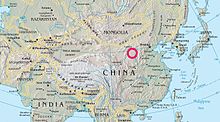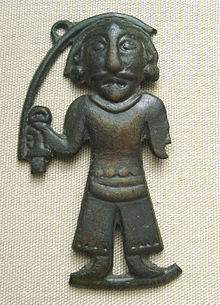| Revision as of 18:13, 25 June 2007 editPer Honor et Gloria (talk | contribs)Autopatrolled, Pending changes reviewers53,031 edits better map← Previous edit | Revision as of 18:16, 25 June 2007 edit undoPer Honor et Gloria (talk | contribs)Autopatrolled, Pending changes reviewers53,031 edits spNext edit → | ||
| Line 10: | Line 10: | ||
| The skeletal remains at Taohongbala tomb dated to between 7th century and 6th century BCE are generally identified as belonging to the Xiongnu bronze culture, and show strong Mongoloid features.<ref>Ma 2005, p. 231</ref><ref>Wuen, . '']'', 1st ed.</ref> | The skeletal remains at Taohongbala tomb dated to between 7th century and 6th century BCE are generally identified as belonging to the Xiongnu bronze culture, and show strong Mongoloid features.<ref>Ma 2005, p. 231</ref><ref>Wuen, . '']'', 1st ed.</ref> | ||
| A |
A similar custom burials at Hulusitai around ] uncovered in 1979, which dated to between 5th century to 4th century BCE is considered as the only Xiongnu's culture situated at the northern slope of ]. The site consisted of mainly bronze artifacts and pottery and 27 horse skeletal remains.<ref>Ma 2005, p. 230-231</ref> Further excavation in 1983 at Guoxianyaozi in total of 31 burials which dated to about 6th century to 5th century BCE, had shown strong north Mongoloid features, those features generally declayed in further south and skeletal remains of east and north Mongoloid, such as those found in Maoqinggou and Yinniugou tombs, which dated to around 7th century BCE can be seen, in total about 117 burials of them.<ref>Ma 2005, p. 232-233, 278-279</ref> Many bronze weapons of those cultures are similar to those of Chinese style.<ref>Ma 2005, p. 282-290</ref> | ||
| Many depicting of Ordos people tend to have straighten hair. Those are especially strong in the archaeological finds at ] (M63:22, M63:23, M84:5) Etuoke (M1, M6), Xihaokou (M3), lower Woertuhao (M3:1), and Mengjialiang.<ref>Ma 2005, p. 188-189</ref> | Many depicting of Ordos people tend to have straighten hair. Those are especially strong in the archaeological finds at ] (M63:22, M63:23, M84:5) Etuoke (M1, M6), Xihaokou (M3), lower Woertuhao (M3:1), and Mengjialiang.<ref>Ma 2005, p. 188-189</ref> | ||
| Line 17: | Line 17: | ||
| ].]] | ].]] | ||
| ] | ] | ||
| Later, horse nomads occupied the area from the ] to the ] before being driven away by the ]. They are considered as some of the |
Later, horse nomads occupied the area from the ] to the ] before being driven away by the ]. They are considered as some of the easternmost people of Scythian affinity to have settled in Central Asian ], just to the east of the better-known ]. They are mainly known from their skeletal remains and artifacts. | ||
| They were in contact and often at war with the pre-Han and ] populations of the period. Their former territory is now located just south of the ] of China, and on the south bank of the northernmost hook of the ]. | They were in contact and often at war with the pre-Han and ] populations of the period. Their former territory is now located just south of the ] of China, and on the south bank of the northernmost hook of the ]. | ||
| Line 26: | Line 26: | ||
| ===Relationships=== | ===Relationships=== | ||
| The Ordos people were the eastern neighbours of, or may have been identical with, the ], who, after being vanquished by the ], migrated to southern Asia to form the ]. They were also culturally related to another nomadic tribe to the east, the ] (Chinese:東胡, "Donghu"), who shared a similar "art of the steppes" but appear to have been |
The Ordos people were the eastern neighbours of, or may have been identical with, the ], who, after being vanquished by the ], migrated to southern Asia to form the ]. They were also culturally related to another nomadic tribe to the east, the ] (Chinese:東胡, "Donghu"), who shared a similar "art of the steppes" but appear to have been Mongoloids.<ref>Lebedynsky, p.124</ref>. They may also have been related to the ] people (Chinese:氐, "Western Barbarians") of Chinese annals. | ||
| By one account, the area of Ordos was the legendary land of origin of the ]. | By one account, the area of Ordos was the legendary land of origin of the ]. | ||
Revision as of 18:16, 25 June 2007

The Ordos culture refers to the various ancient settlers of the area of the Ordos Desert, in the south of the Inner Mongolian Autonomous Region of the People's Republic of China, about 300 kilometers from modern Beijing.
Prehistoric people
The Ordos culture is documented from the Upper Palaeolithic. They used the chopping and rock tools of the Zhoukoudian. The points and sides of their tools indicate a "Moustero-Levalloisian" element. They seemed to have a masterful knowledge of Upper Palaeolithic technology, producing blades as much as fifteen centimeters long.
The human fossil remains of the Ordos Man from Salawusu site dated between 50,000 and 35,000 BCE show strong Mongoloid features, specifically on the fore-tooth and occipital bone.

The skeletal remains at Taohongbala tomb dated to between 7th century and 6th century BCE are generally identified as belonging to the Xiongnu bronze culture, and show strong Mongoloid features.
A similar custom burials at Hulusitai around Bayannur uncovered in 1979, which dated to between 5th century to 4th century BCE is considered as the only Xiongnu's culture situated at the northern slope of Yinshan. The site consisted of mainly bronze artifacts and pottery and 27 horse skeletal remains. Further excavation in 1983 at Guoxianyaozi in total of 31 burials which dated to about 6th century to 5th century BCE, had shown strong north Mongoloid features, those features generally declayed in further south and skeletal remains of east and north Mongoloid, such as those found in Maoqinggou and Yinniugou tombs, which dated to around 7th century BCE can be seen, in total about 117 burials of them. Many bronze weapons of those cultures are similar to those of Chinese style.
Many depicting of Ordos people tend to have straighten hair. Those are especially strong in the archaeological finds at Baotou (M63:22, M63:23, M84:5) Etuoke (M1, M6), Xihaokou (M3), lower Woertuhao (M3:1), and Mengjialiang.
Scythian nomads


Later, horse nomads occupied the area from the 6th century BCE to the 2nd century BCE before being driven away by the Xiongnu. They are considered as some of the easternmost people of Scythian affinity to have settled in Central Asian steppes, just to the east of the better-known Yuezhi. They are mainly known from their skeletal remains and artifacts.
They were in contact and often at war with the pre-Han and Han populations of the period. Their former territory is now located just south of the Great Wall of China, and on the south bank of the northernmost hook of the Yellow river.
The people represented in archaeological finds tend to display Europoïd features, and are thought to be of Scythian affinity. The weapons, found in tombs throughout the steppes of the Ordos, are very close to those of the Scythians, especially the Sakas.
The Ordos people manufactured belt plaques, horse gear and weapons depicting animals, often in combat. The "animal-style" is similar to nomadic traditions found in Central Asia, such as that of the Scythians.
Relationships
The Ordos people were the eastern neighbours of, or may have been identical with, the Yuezhi, who, after being vanquished by the Xiongnu, migrated to southern Asia to form the Kushan empire. They were also culturally related to another nomadic tribe to the east, the Eastern Hu (Chinese:東胡, "Donghu"), who shared a similar "art of the steppes" but appear to have been Mongoloids.. They may also have been related to the Di people (Chinese:氐, "Western Barbarians") of Chinese annals.
By one account, the area of Ordos was the legendary land of origin of the Turks.
Xiongnu occupation
In Chinese accounts, the Xiongnu first appear at Ordos in the Yizhoushu and Shanhaijing during the Warring States Period before it was occupied by Qin. It is generally thought to be their homeland, however when exactly they came to presence is unclear. Just as the Xiongnu expanded southward into Yuezhi territory around 160 BCE under their leader Modun, it is thought they also occupied the Ordos area during the same period, when they came in direct contact with the Chinese.
Artifacts
Main artifacts of the Ordos people, as displayed in the British Museum (Asian Gallery):
-
Bronze pole top, Ordos, 6th-5thCentury BCE.
-
Horse attacked by tiger, Ordos, 4th-1st century BCE.
-
Silver horse, Ordos, 4th-1st century BCE.
-
Belt buckle, Ordos, 3rd-1st century BCE.
-
Belt buckle, Ordos, 3rd-1st century BCE.
-
 Ordos bronze horses, 5th-3rd century BCE.
Ordos bronze horses, 5th-3rd century BCE.
Notes
- Jacquetta Hawkes and Sir Leonard Woolley, History of Mankind: Volume I. (New York: Harper and Row, 1963), p.172.
- Weiwen, Huang, Salawusu Relic. Encyclopedia of China, 1st ed.
- Ma 2005, p. 231
- Wuen, Taohongbala Tombs. Encyclopedia of China, 1st ed.
- Ma 2005, p. 230-231
- Ma 2005, p. 232-233, 278-279
- Ma 2005, p. 282-290
- Ma 2005, p. 188-189
- "Europoid faces in some depictions of the Ordos, which should be attributed to a Scythian affinity", Iaroslav Lebedynsky, p125
- Iaroslav Lebedynsky, p127
- Lebedynsky, p.124
- Ma 2005, p. 220-225
References
- British Museum permanent exhibition (China room)
- "Les nomades" Iaroslav Lebedynsky, Editions Errance, Paris 2007, ISBN 9782877723466
- Ma, Liqing (2005). Original Xiongnu, An Archaeological Explore on the Xiongnu's History and Culture. Hohhot: Inner Mongolia University Press. ISBN 7-81074-796-7.
- Huang, Weiwen, Salawusu Relic. Encyclopedia of China, 1st ed.
- Wuen, Taohongbala Tombs. Encyclopedia of China, 1st ed.